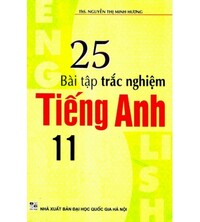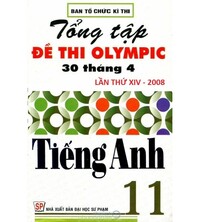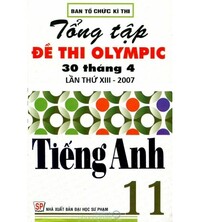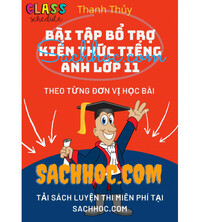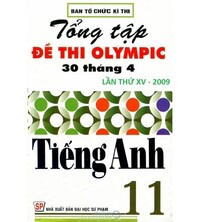Tiếng Anh 11 Unit 4 4.2 Grammar
1. In pairs, guess the answers to the questions. Then read the text and check your ideas. 2. Read the GRAMMAR FOCUS and complete the examples with the words in blue in the text. 3. Complete the text with a, an, the or Ø (no article). Then listen and check. What has Jack Ng invented and why? 4. Read the sentences and cross out the article if it isn't necessary. 5. Complete the questions with a, an or the. Then, in pairs, ask and answer the questions.
Bài 1
1. In pairs, guess the answers to the questions. Then read the text and check your ideas.
(Theo cặp, đoán câu trả lời cho các câu hỏi. Sau đó đọc văn bản và kiểm tra ý tưởng của bạn.)
1. What was the world population in 1900? What is it now? What will it be in 2050?
(Dân số thế giới năm 1900 là bao nhiêu? Bây giờ là bao nhiêu? Nó sẽ bao nhiêu vào năm 2050?)
2. What is the biggest change in where people live?
(Sự thay đổi lớn nhất ở nơi mọi người sống là gì?)
3. What are 'megacities"?
(Siêu đô thị là gì?)
The world's growing problem
A famous scientist said recently that there's a growing problem in the world, and the problem is people there are just too many of us! Because of economic growth, food and health care have improved and people are living longer. During the twentieth century the population of the world grew from 1.65 billion to 6 billion. Today, it is 7 billion and by 2050 it is predicted to reach 9.2 billion.
For the first time in history. more people live in cities than in the countryside. Across the globe, there are 27 megacities- cities with more than 10 million inhabitants and by 2025 the United Nations predicts the total will be 36. Megacities are more common in Asia, particularly in India and China. The biggest megacity is still Tokyo, with a population of 34,500,000.
Phương pháp giải:
Tạm dịch:
Vấn đề gia tăng dân số của thế giới
Một nhà khoa học nổi tiếng gần đây đã nói rằng có một vấn đề ngày càng gia tăng trên thế giới, và vấn đề là chúng ta có quá nhiều người! Do tăng trưởng kinh tế, thực phẩm và chăm sóc sức khỏe đã được cải thiện và mọi người đang sống lâu hơn. Trong thế kỷ 20, dân số thế giới đã tăng từ 1,65 tỷ lên 6 tỷ. Ngày nay, con số này là 7 tỷ và đến năm 2050, con số này được dự đoán sẽ đạt 9,2 tỷ.
Lần đầu tiên trong lịch sử. nhiều người sống ở thành phố hơn ở nông thôn. Trên toàn cầu, có 27 siêu đô thị- thành phố với hơn 10 triệu dân và đến năm 2025, Liên Hợp Quốc dự đoán tổng số sẽ là 36. Các siêu đô thị phổ biến hơn ở châu Á, đặc biệt là ở Ấn Độ và Trung Quốc. Siêu đô thị lớn nhất vẫn là Tokyo, với dân số 34.500.000 người.
Lời giải chi tiết:
1. The world population in 1900 was 1.65 billion. Now is 7 billion and in 2050 it will be 9.2 billion.
(Dân số thế giới năm 1900 là 1,65 tỷ người. Bây giờ là 7 tỷ và năm 2050 sẽ là 9,2 tỷ.)
2. For the first time in history. more people live in cities than in the countryside. Across the globe, there are 27 megacities- cities with more than 10 million inhabitants.
(Lần đầu tiên trong lịch sử. nhiều người sống ở thành phố hơn ở nông thôn. Trên toàn cầu, có 27 siêu đô thị - thành phố với hơn 10 triệu dân.)
3. A megacity is a very large city, typically with a population of more than 10 million people.
(Siêu đô thị là một thành phố rất lớn, thường có dân số hơn 10 triệu người.)
Bài 2
2. Read the GRAMMAR FOCUS and complete the examples with the words in blue in the text.
(Đọc NGỮ PHÁP TRỌNG TÂM và hoàn thành các ví dụ với các từ màu xanh lam trong văn bản.)
|
GRAMMAR FOCUS Articles No article ・You don't use an article when you talk about things in general. ... Ø health care have improved and 1_______ are living longer. ・You don't use an article with continents, countries or cities. Ø Asia, Ø India, 2_______ Exceptions: the United States, the United Kingdom, the Netherlands, etc. Indefinite article a/an ・You use a/an to talk about something for the first time when it means “one of many” There's 3_______ in the world... (There are many problems and this is one of them.) ・You use a/an with jobs. 4_______ said recently... Definite article the ・You use the when the thing you are talking about has already been mentioned. There's a growing problem in the world, and 5_______ is people ... ・You use the when the thing you are talking about is known or is 'the only one' the population of 6_______ ・You use the with historical periods, superlatives and ordinal numbers. During the twentieth century... 7_______megacity is still Tokyo… |
Lời giải chi tiết:
|
1. people |
2. China |
3. a growing problem |
4. A famous scientist |
|
5. the problem |
6. the world |
7. the biggest |
|
GRAMMAR FOCUS
Articles (Mạo từ)
No article (Không có mạo từ)
• You don't use an article when you talk about things in general.
(Không dùng mạo từ khi nói về những thứ chung chung.)
... Ø health care have improved and 1people are living longer.
(Chăm sóc sức khỏe đã được cải thiện và con người sống lâu hơn.)
• You don't use an article with continents, countries or cities.
(Không sử dụng mạo từ với các lục địa, quốc gia hoặc thành phố.)
Ø Asia, Ø India, 2China
(Châu Á, Ấn Độ, Trung Quốc)
Exceptions: the United States, the United Kingdom, the Netherlands, etc.
(Ngoại lệ: Hoa Kỳ, Vương quốc Anh, Hà Lan, v.v.)
Indefinite article a/an
(Mạo từ không xác định a/an)
• You use a/an to talk about something for the first time when it means “one of many”
(Sử dụng a/an để nói về điều gì đó lần đầu tiên khi nó có nghĩa là “một trong nhiều”)
There's 3a growing problem in the world... (There are many problems and this is one of them.)
(Có một vấn đề đang gia tăng trên thế giới... (Có rất nhiều vấn đề và đây là một trong số đó.))
•You use a/an with jobs. 4A famous scientist said recently...
(Sử dụng a/an với công việc. Một nhà khoa học nổi tiếng gần đây cho biết...)
Definite article the
(Mạo từ xác định - the)
•You use the when the thing you are talking about has already been mentioned.
(Sử dụng the khi điều bạn đang nói đến đã được đề cập.)
There's a growing problem in the world, and 5the problem is people ...
(Có một vấn đề ngày càng gia tăng trên thế giới, và vấn đề là con người ...)
•You use the when the thing you are talking about is known or is 'the only one'
(Bạn sử dụng the khi điều mà bạn đang nói đến đã được biết đến hoặc là nó chỉ là thứ duy nhất.)
the population of 6the world
(dân số của thế giới)
•You use the with historical periods, superlatives and ordinal numbers.
(Bạn sử dụng the với các giai đoạn lịch sử, so sánh nhất và số thứ tự.)
During the twentieth century...
(Trong thế kỷ hai mươi...)
7The biggest megacity is still Tokyo…
(Siêu đô thị lớn nhất vẫn là Tokyo…)
Bài 3
3. Complete the text with a, an, the or Ø (no article). Then listen and check. What has Jack Ng invented and why?
(Hoàn thành đoạn văn với a, an, the hoặc Ø (không có mạo từ). Sau đó nghe và kiểm tra. Jack Ng đã phát minh ra cái gì và tại sao?)
Vertical farms in Singapore
1The biggest problem that megacities have is how to provide 2 Ø food and 3____water for their inhabitants. One small country may have found 4____ solution: Singapore is 5____ country which is famous for 6____ innovation 7____ tiny country has very little space to grow 8____ food. But Jack Ng, 9____ farmer, has invented 10____ vertical farm. It only produces a few different kinds of vegetable, but there are plans to expand 11____ vertical farm to include 12____ more plants.
Lời giải chi tiết:
|
1. The |
2. Ø |
3. Ø |
4. a |
|
5. a |
6. Ø |
7. The |
8. Ø |
|
9. a |
10. a |
11. the |
12. Ø |
Giải thích:
(1) Trong so sánh nhất dùng mạo từ “the” => the biggest problem
(2) + (3) Trước danh không đếm được “food” (thức ăn) và “water” (nước), không xác định không dùng mạo từ => Ø
(4) + (5) Trước danh từ số ít, không xác định “solution” (giải pháp) và “country” (quốc gia) => a
(6) Trước danh không đếm được “innovation” (sự cải tiến), không xác định không dùng mạo từ => Ø
(7) Trước danh từ xác định được nhắc đến từ lần thứ hai trong văn bản “country” => the
(8) Trước danh không đếm được “food” (thức ăn) không xác định không dùng mạo từ => Ø
(9) + (10) Trước danh từ số ít, không xác định “farmer” (nông dân) và “farm” (nông trại) => a
(11) Trước danh từ xác định được nhắc đến từ lần thứ hai trong văn bản “vertical farm” => the
(12) Trước danh từ số nhiều nói chung "plants" (cây cối/ thực vật), chưa xác định, không dùng mạo từ => Ø
Vertical farms in Singapore
1The biggest problem that megacities have is how to provide 2 Ø food and 3Ø water for their inhabitants. One small country may have found 4a solution: Singapore is 5a country which is famous for 6Ø innovation. 7The tiny country has very little space to grow 8Ø food. But Jack Ng, 9a farmer, has invented 10a vertical farm. It only produces a few different kinds of vegetable, but there are plans to expand 11the vertical farm to include 12Ø more plants.
Tạm dịch:
Trang trại thẳng đứng ở Singapore
Vấn đề lớn nhất mà các siêu đô thị gặp phải là làm thế nào để cung cấp thức ăn và nước uống cho cư dân của họ. Một quốc gia nhỏ có thể đã tìm ra giải pháp: Singapore là quốc gia nổi tiếng về đổi mới. Đất nước nhỏ bé có rất ít không gian để trồng lương thực. Nhưng nông dân Jack Ng đã phát minh ra trang trại thẳng đứng. Nó chỉ sản xuất một số loại rau khác nhau, nhưng có kế hoạch mở rộng trang trại thẳng đứng để bao gồm nhiều loại cây hơn.
Bài 4
4. Read the sentences and cross out the article if it isn't necessary.
(Đọc các câu và gạch bỏ mạo từ nếu nó không cần thiết.)
1. The poverty doesn't exist in big cities.
2. The cheapest form of public transport is the bus.
3. The food is mainly sold in big supermarkets.
4. The education and the healthcare are free.
5. The capital city is located in the north.
6. The pollution is only a problem in major industrial areas.
Lời giải chi tiết:
1. The poverty doesn't exist in big cities.
(Cái nghèo không xuất hiện trong thành phố lớn.)
Giải thích: Trước danh từ trừu tượng không đếm được "poverty" (sự nghèo nàn) không dùng mạo từ.
2. The cheapest form of public transport is the bus.
(Loại hình phương tiện rẻ nhất là xe buýt.)
3. The food is mainly sold in big supermarkets.
(Đồ ăn chủ yếu được bán trong các siêu thị lớn.)
Giải thích: Trước danh từ không đếm được "food" (thức ăn) không dùng mạo từ.
4. The education and the healthcare are free.
(Giáo dục và chăm sóc sức khỏe được miễn phí.)
Giải thích: Trước danh từ trừu tượng, không đếm được "education" (giáo dục) và "healthcare" (chăm sóc sức khỏe) không dùng mạo từ.
5. The capital city is located in the north.
(Thủ đô thành phố nằm ở phía Bắc.)
6. The pollution is only a problem in major industrial areas.
(Ô nhiễm chỉ là vấn đề chủ yếu ở các khu công nghiệp.)
Giải thích: Trước danh từ không đếm được "pollution" (sự ô nhiễm) không dùng mạo từ.
Bài 5
5. Complete the questions with a, an or the. Then, in pairs, ask and answer the questions.
(Hoàn thành các câu hỏi với a, an hoặc the. Sau đó, theo cặp, hỏi và trả lời các câu hỏi.)
1. Do you live in the countryside?
2. Do you know ___ Great Barrier Reef?
3. Which one is bigger, ___ humpback whale or blue whale?
4. ___ eruption like this one can be dangerous and deadly.
5. Do you know the name of ___ longest mountain range in the world?
6. Do you like___ calm sea or___ rough sea?
Lời giải chi tiết:
|
1. the |
2. the |
3. a |
|
4. The |
5. the |
6. a - a |
1. Do you live in the countryside?
(Bạn sống ở nông thôn phải không?)
Giải thích: Cụm từ “in the countryside” (ở nông thôn).
2. Do you know the Great Barrier Reef?
(Bạn có biết rặng san hô Great Barrier không?)
Giải thích: Trước tên địa danh nổi tiếng duy nhất trên thế giới dùng mạo từ “the”.
3. Which one is bigger, a humpback whale or blue whale?
(Con nào lớn hơn, cá voi lưng gù hay cá voi xanh?)
Giải thích: Trước danh từ số ít chưa xác định nói chung, bắt đầu bằng phụ âm dùng mạo từ “a”.
4. The eruption like this one can be dangerous and deadly.
(Vụ phun trào như thế này có thể nguy hiểm và chết người.)
Giải thích: Trước danh từ xác định “like this” dùng mạo từ “the”.
5. Do you know the name of the longest mountain range in the world?
(Bạn có biết tên dãy núi dài nhất thế giới không?)
Giải thích: Trong so sánh nhất dùng mạo từ “the” => the longest
6. Do you like a calm sea or a rough sea?
(Bạn thích biển lặng hay biển động?)
Giải thích: Trước danh từ số ít chưa xác định nói chung, bắt đầu bằng phụ âm dùng mạo từ “a”.
Search google: "từ khóa + timdapan.com" Ví dụ: "Tiếng Anh 11 Unit 4 4.2 Grammar timdapan.com"
